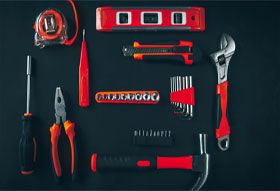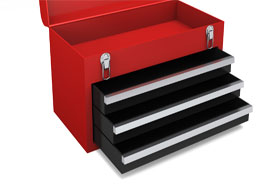Toolbox Foam Inserts | Custom Foam Inserts for Toolboxes

Discover how to organise your tool collection with easy to make toolbox foam inserts. One of those highly aggravating moments in life is when you need a particular tool, and you cannot find it anywhere. It's typically the only tool missing, and you have to turn the place upside down looking for it. When you're trying to fix something and need just a Philips screwdriver to complete the task, not being able to find it for over half an hour can make you want to pull your hair out.
Of course, we could all do with a bit of organisation, and getting your tools organised can mean jobs are more straightforward, less time consuming, and more of a joy.
Something that can make all the difference and is an easy and cost-effective solution for better tool organisation is to make DIY custom foam inserts for your toolbox. Your nerves and your temper will be far better for it!
Best Foam Insert for Toolbox?
Lost tools will become a thing of the past once you get these foam inserts into place. Each one is usually made of closed-cell foam and is cut to fit and hold your tools in place.
- To get started, you need to gather a few items to build your custom toolbox foam inserts:
- Foam Sheets (closed-cell)
- Adhesive Spray Glue
- Sharp knife or craft knife
- A marker pen
The only skills you will need for this is to be able to do a bit of tracing, cutting and glueing, and you'll have all you need to make your own bespoke toolbox foam liner.
Foam Toolbox Inserts Measurements
There are a few simple steps to follow when creating your bespoke toolbox foam liners. The first one is to figure out how much foam to order.

Keep in mind that the foam sheets need to fit snugly in the drawer. Follow the adage 'measure twice, cut once', and you'll be on the right side. Once you've got your measurements down, you need to choose which type of foam to use. Although there are many types of foam available, in this case, it's best to use closed-cell foams as it's going to be moisture resistant and that will afford your tools some protection against rust.
Ideally, you'll use LD33 Plastazote - a superior closed cell foam. It's rigid foam and is durable and long-lasting to give you the service you need. Order two layers of foam. One will be used as the bottom layer and should be white or bright coloured, and the other a darker colour for holding your tools in place. The benefit of this approach is that you'll quickly see when there is a tool missing, and it will be a reminder for you to put it back into place. The darker colour as the top layer will work better over time and won't 'show the dirt'. To ensure the tools fit snugly, the top layer needs to be thicker or deeper to have them in place, and they won't be so likely to slide around.
Now that you have what you need, you need to trim the sheets to match the space you will use. Be generous with your cutting and sizing so that the shapes fit snugly, and you can always retrim if it's just too large. We recommend using either a workbench or a cutting board with your craft knife. Once you have the sheets cut to size, now it's time to add your tools. Now trace the outside of each tool with a marker. If you make a mistake, or it doesn't look to be perfect, don't worry too much as you'll be glueing it down onto the bottom layer. By cutting along your traced lines, you should get a snug fit for your tools that will grip it and hold it into place. Some people like to add finger slots to make it easier to pull the tools out.
It's now time to glue the two layers together. Put down layers of bedsheets or newspaper to protect your surface. Spray your adhesive onto the cutout layer. Otherwise, you'll end up with a sticky sheet to which your tools could get stuck. Give the glue a few seconds to get tacky, then carefully put the top layer onto the coloured or white base layer. Apply firm pressure for a few seconds and give the glue a chance to bond and dry. When it's dry, you can put the insert into your drawer and add your tools.
Regarding the materials you need for this project, you can buy closed-cell foams from us, and we also sell spray adhesive for you to complete your project. Should you need any further advice, please feel free to contact us to discuss.
